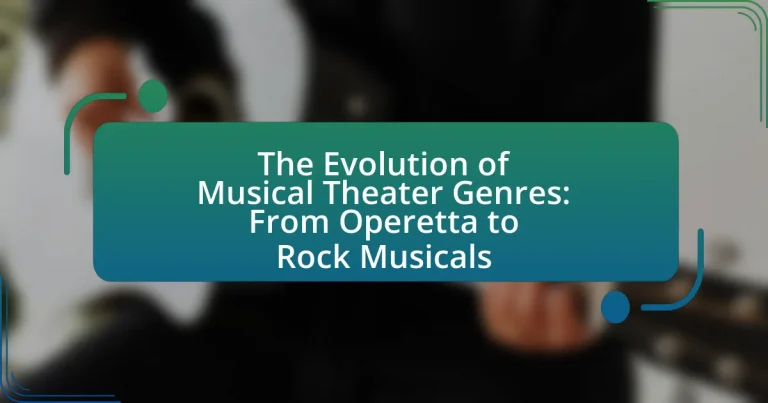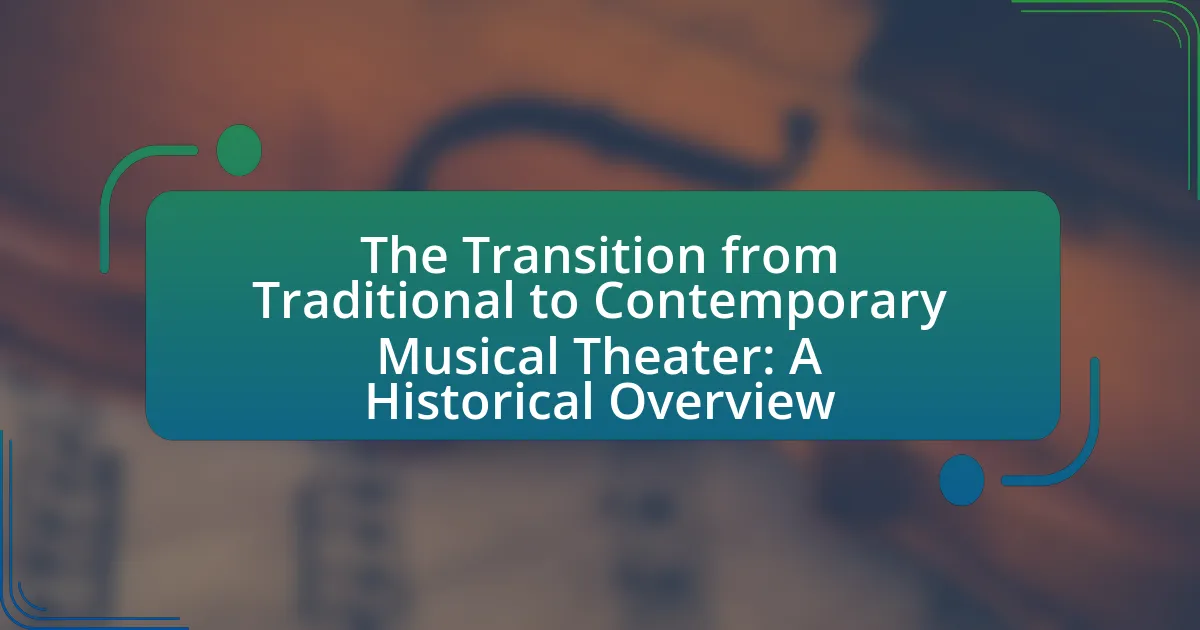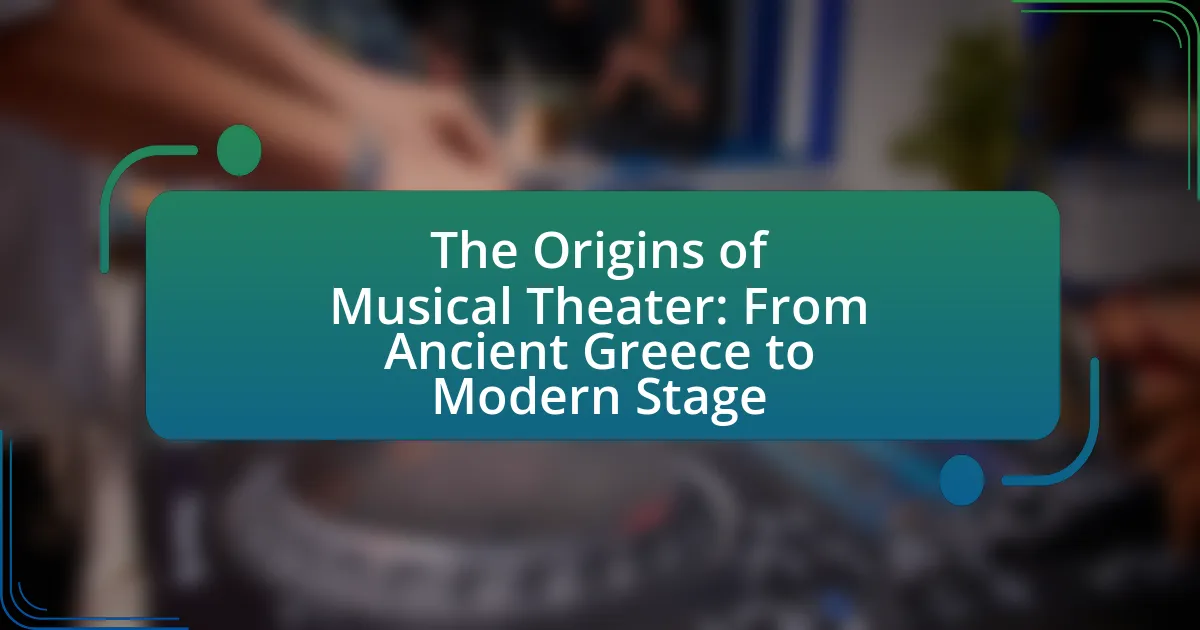The article examines the evolution of musical theater genres, tracing their development from the 19th-century operetta to contemporary rock musicals. It highlights key historical milestones, such as the emergence of the American musical and the Golden Age of Broadway, while discussing the influence of cultural shifts on thematic content and musical styles. The piece also explores the defining characteristics of various genres, including operetta, traditional book musicals, and rock musicals, and considers the impact of technology and societal changes on the future of musical theater. Through this analysis, the article provides insights into how musical theater has adapted over time, reflecting broader cultural dynamics and audience preferences.

What is the Evolution of Musical Theater Genres?
The evolution of musical theater genres spans from the operetta of the 19th century to contemporary rock musicals. Initially, operettas, characterized by light music and romantic themes, emerged in Europe, particularly through the works of composers like Johann Strauss II and Gilbert and Sullivan. In the early 20th century, the American musical began to take shape, integrating elements of jazz and popular music, with notable examples including “Show Boat” by Jerome Kern, which introduced serious themes and complex characters.
The mid-20th century saw the rise of the book musical, where the narrative and songs were closely intertwined, exemplified by productions like “Oklahoma!” by Rodgers and Hammerstein. This period also marked the introduction of diverse styles, including rock and pop influences in the 1960s and 1970s, as seen in “Hair” and “Jesus Christ Superstar.” The late 20th century and early 21st century further diversified the genre with the emergence of rock musicals, such as “Rent” and “Hamilton,” which incorporated contemporary music styles and addressed social issues.
This progression illustrates how musical theater has continuously adapted to cultural shifts, reflecting societal changes and evolving musical trends.
How did musical theater genres originate and develop over time?
Musical theater genres originated from a blend of various theatrical forms, including opera, vaudeville, and folk traditions, evolving significantly from the 19th century onward. The operetta, characterized by light opera and spoken dialogue, emerged in Europe, particularly through the works of composers like Johann Strauss II and Gilbert and Sullivan, laying the groundwork for modern musical theater.
As the 20th century progressed, American musical theater began to take shape with the introduction of the Broadway musical, which integrated song, dance, and narrative, exemplified by productions such as “Show Boat” in 1927, which addressed serious themes and showcased a more cohesive storytelling approach. The genre continued to diversify with the advent of rock musicals in the 1960s, such as “Hair,” which incorporated contemporary music styles and social commentary, reflecting cultural shifts.
The development of musical theater genres has been marked by innovations in style and content, with each era responding to societal changes and artistic movements, thus creating a rich tapestry of theatrical expression that continues to evolve today.
What are the key historical milestones in the evolution of musical theater?
Key historical milestones in the evolution of musical theater include the emergence of operetta in the mid-19th century, which combined spoken dialogue with songs, exemplified by Jacques Offenbach’s “Orpheus in the Underworld.” The early 20th century saw the rise of the American musical, with landmark productions like “Show Boat” (1927) by Jerome Kern and Oscar Hammerstein II, which integrated music and narrative. The Golden Age of Broadway, spanning the 1940s to 1960s, featured iconic works such as “Oklahoma!” (1943) and “West Side Story” (1957), which pushed the boundaries of storytelling through music. The rock musical genre emerged in the late 1960s, with “Hair” (1967) marking a significant cultural shift, followed by “Rent” (1996), which further transformed the landscape by addressing contemporary social issues. Each of these milestones reflects a significant evolution in musical theater, showcasing its adaptability and cultural relevance over time.
How did cultural influences shape the development of musical theater genres?
Cultural influences significantly shaped the development of musical theater genres by integrating diverse musical styles, themes, and narratives reflective of societal values and historical contexts. For instance, the emergence of American musical theater in the early 20th century was heavily influenced by African American musical traditions, such as jazz and blues, which introduced new rhythms and emotional depth, evident in productions like “Porgy and Bess” by George Gershwin. Additionally, the incorporation of European operetta elements, characterized by light-hearted storytelling and melodic tunes, laid the groundwork for Broadway musicals, as seen in works by composers like Gilbert and Sullivan. The evolution of rock musicals in the 1960s and 1970s, such as “Hair,” was a direct response to the counterculture movement, reflecting the social upheaval and changing attitudes of the time. These examples illustrate how cultural dynamics, including race, social movements, and historical events, have continually influenced the thematic and stylistic evolution of musical theater genres.
What are the main genres of musical theater?
The main genres of musical theater include operetta, traditional book musicals, rock musicals, and jukebox musicals. Operetta, which originated in the 19th century, combines music, dialogue, and dance, often featuring light-hearted themes. Traditional book musicals, popularized in the 20th century, focus on a cohesive narrative with character development, exemplified by works like “Oklahoma!” and “West Side Story.” Rock musicals emerged in the late 20th century, integrating rock music into storytelling, as seen in “Hair” and “Rent.” Jukebox musicals, which utilize existing popular songs to create a narrative, have gained prominence with productions like “Mamma Mia!” and “Jersey Boys.” These genres reflect the diverse evolution of musical theater over time.
What defines operetta as a musical theater genre?
Operetta is defined as a musical theater genre characterized by its light, often comedic narrative, combined with spoken dialogue and musical numbers. This genre typically features romantic plots, whimsical characters, and a blend of operatic and popular musical styles, making it accessible to a broad audience. Historically, operettas emerged in the mid-19th century, with composers like Jacques Offenbach and Gilbert and Sullivan popularizing the form, which emphasized satire and social commentary within its entertaining framework.
How did the golden age of musicals influence modern genres?
The golden age of musicals significantly influenced modern genres by establishing foundational elements such as storytelling through song, character development, and the integration of dance. This era, spanning from the 1920s to the 1960s, introduced iconic works like “Oklahoma!” and “West Side Story,” which showcased how music could enhance narrative depth and emotional resonance. These innovations paved the way for contemporary musicals, including rock and hip-hop genres, which continue to utilize these storytelling techniques while incorporating diverse musical styles. The impact is evident in modern productions like “Hamilton,” which blends historical narrative with rap, demonstrating the lasting legacy of the golden age’s emphasis on narrative-driven musicality.
What characteristics distinguish rock musicals from other genres?
Rock musicals are distinguished from other genres primarily by their integration of rock music as a central element, which often includes electric guitars, strong rhythms, and contemporary lyrical themes. Unlike traditional musicals that typically feature orchestral arrangements and classical styles, rock musicals embrace a more modern sound that reflects youth culture and social issues. For example, productions like “Hair” and “Rent” utilize rock music to convey messages about rebellion, love, and societal challenges, making them resonate with younger audiences. This genre also tends to prioritize character-driven narratives and emotional authenticity, often employing a more informal and conversational style in dialogue and lyrics compared to the more structured formats of operettas or classic musicals.

What are the key characteristics of Operetta?
Operetta is characterized by its light, comedic tone, often featuring romantic plots and spoken dialogue interspersed with songs. This genre typically includes elements such as a small cast, simple orchestration, and a focus on melody, making it accessible and entertaining. Historically, operettas emerged in the mid-19th century, with composers like Johann Strauss II and Gilbert and Sullivan popularizing the form through works that combined humor with social commentary, thus reinforcing its appeal and cultural significance.
How does operetta differ from traditional opera?
Operetta differs from traditional opera primarily in its lighter, more comedic tone and shorter length. While traditional opera often features serious themes and complex musical compositions, operetta typically includes spoken dialogue, simpler melodies, and a focus on entertaining plots, often with romantic or humorous elements. Historical context shows that operetta emerged in the mid-19th century, with composers like Johann Strauss II and Gilbert and Sullivan popularizing the genre, which contrasts with the grand, dramatic narratives found in operas by composers such as Verdi and Wagner.
What musical elements are unique to operetta?
Operetta is characterized by its light, often comedic style, featuring distinct musical elements such as spoken dialogue, lyrical melodies, and a blend of operatic and popular music forms. These elements create a unique atmosphere that differentiates operetta from traditional opera, which typically relies solely on sung dialogue. The use of ensemble numbers and duets is also prominent in operetta, allowing for character interaction and development through music. Additionally, operettas often incorporate dance and orchestration that reflects popular music trends of their time, enhancing their accessibility and appeal to a broader audience.
How did operetta influence later musical theater forms?
Operetta significantly influenced later musical theater forms by introducing a blend of spoken dialogue, song, and dance, which became foundational elements in modern musicals. This genre, particularly prominent in the 19th century, showcased light-hearted themes and romantic plots, setting a precedent for the narrative structure and character development seen in contemporary musical theater. Notably, composers like Johann Strauss II and Gilbert and Sullivan incorporated catchy melodies and witty lyrics, which inspired later creators such as Rodgers and Hammerstein, who further developed these elements into the American musical format. The operetta’s emphasis on entertainment and accessibility paved the way for diverse styles, including the integration of popular music genres, ultimately shaping the evolution of musical theater into the multifaceted art form it is today.
What role did operetta play in the evolution of musical theater?
Operetta played a crucial role in the evolution of musical theater by bridging the gap between traditional opera and modern musical forms. Originating in the mid-19th century, operetta introduced lighter themes, spoken dialogue, and popular music styles, which laid the groundwork for the development of the American musical. Notably, composers like Johann Strauss II and Gilbert and Sullivan incorporated humor and relatable characters, making the genre more accessible to broader audiences. This shift towards entertainment-focused narratives and catchy melodies influenced later musical theater styles, including the Broadway musical, which emerged in the early 20th century, ultimately shaping the diverse landscape of contemporary musical theater.
How did operetta pave the way for the development of Broadway musicals?
Operetta paved the way for the development of Broadway musicals by introducing a blend of spoken dialogue, songs, and dance, which became foundational elements of the musical theater genre. This form of entertainment, particularly popular in the 19th century, emphasized lighthearted themes and accessible melodies, setting a precedent for the narrative structure and musical integration seen in later Broadway productions. Notably, composers like Gilbert and Sullivan showcased how operetta could successfully combine humor and social commentary, influencing American composers such as George M. Cohan and Jerome Kern, who further developed these concepts into the modern musical format. The operetta’s emphasis on character-driven stories and catchy tunes directly contributed to the evolution of Broadway musicals, establishing a framework that would be expanded upon in the 20th century.
What notable operettas have had a lasting impact on musical theater?
Notable operettas that have had a lasting impact on musical theater include “The Mikado” by Gilbert and Sullivan, “The Merry Widow” by Franz Lehár, and “H.M.S. Pinafore,” also by Gilbert and Sullivan. “The Mikado,” first performed in 1885, introduced elements of satire and humor that influenced future musical comedies. “The Merry Widow,” premiered in 1905, popularized the use of romantic and lush melodies, setting a standard for operatic musical numbers in theater. “H.M.S. Pinafore,” debuted in 1878, showcased the integration of music and narrative, paving the way for the modern musical format. These operettas established foundational structures and themes that continue to resonate in contemporary musical theater.

How did the transition from traditional musicals to rock musicals occur?
The transition from traditional musicals to rock musicals occurred primarily in the 1960s and 1970s, driven by cultural shifts and the influence of rock music on popular culture. Traditional musicals, characterized by their orchestral scores and structured song-and-dance numbers, began to evolve as composers like Stephen Schwartz and Andrew Lloyd Webber incorporated rock elements into their works, exemplified by shows such as “Hair” and “Jesus Christ Superstar.” These productions featured contemporary themes, a more informal style, and a focus on youth culture, reflecting societal changes of the era. The success of these rock musicals demonstrated a new audience appetite for innovative storytelling through music, marking a significant departure from the conventions of earlier musical theater.
What factors contributed to the rise of rock musicals?
The rise of rock musicals was primarily influenced by cultural shifts in the 1960s and 1970s, particularly the counterculture movement and the popularity of rock music. This era saw a growing disillusionment with traditional forms of entertainment, leading to a demand for more relatable and contemporary storytelling in theater. Notable examples include “Hair,” which debuted in 1967 and addressed social issues like war and civil rights through a rock score, reflecting the sentiments of the youth at the time. Additionally, the integration of rock music into musicals allowed for a more dynamic and energetic performance style, appealing to a broader audience and contributing to the genre’s popularity. The success of these productions demonstrated that rock music could effectively convey complex emotions and narratives, solidifying its place in the musical theater landscape.
How did societal changes influence the themes of rock musicals?
Societal changes significantly influenced the themes of rock musicals by reflecting the cultural, political, and social upheavals of the 1960s and 1970s. The rise of counterculture movements, civil rights activism, and anti-war sentiments led to narratives that challenged traditional norms and explored themes of rebellion, identity, and social justice. For instance, the rock musical “Hair” directly addressed issues such as the Vietnam War and the quest for personal freedom, embodying the spirit of the era. Additionally, the incorporation of rock music resonated with younger audiences, making the themes more relatable and impactful, as evidenced by the popularity of productions that tackled contemporary issues, thus reshaping the landscape of musical theater.
What are some landmark rock musicals that defined the genre?
Some landmark rock musicals that defined the genre include “Hair,” “Jesus Christ Superstar,” and “Rent.” “Hair,” which premiered in 1967, is often credited with bringing rock music to the stage, addressing themes of counterculture and anti-war sentiments. “Jesus Christ Superstar,” released in 1970, redefined musical storytelling by blending rock music with biblical narratives, becoming a significant cultural phenomenon. “Rent,” which debuted in 1996, further pushed the boundaries by incorporating contemporary issues such as HIV/AIDS and LGBTQ+ representation, solidifying its impact on modern musical theater. These productions collectively illustrate the evolution and significance of rock musicals within the broader context of musical theater.
What are the defining features of rock musicals?
Rock musicals are characterized by their integration of rock music into the narrative structure, often featuring contemporary themes and a youthful energy. These musicals typically utilize electric guitars, drums, and a strong vocal style that reflects rock music’s rebellious spirit. Notable examples include “Hair,” which addresses social issues like war and civil rights, and “Rent,” which explores themes of love and loss in the context of the AIDS crisis. The use of rock music in these productions not only enhances emotional expression but also connects with a younger audience, making the genre distinct from traditional musicals that often rely on classical or Broadway-style music.
How does the music in rock musicals differ from other genres?
The music in rock musicals differs from other genres primarily through its incorporation of rock music elements, characterized by electric guitars, strong backbeats, and a focus on contemporary themes. Unlike traditional musicals that often utilize orchestral arrangements and classical structures, rock musicals embrace a more modern sound that resonates with youth culture and social issues. For example, “Hair,” one of the first rock musicals, features songs that address counterculture movements and personal freedom, reflecting the societal changes of the 1960s. This shift in musical style not only alters the emotional tone of the performances but also expands the narrative possibilities, allowing for a more direct connection with the audience’s experiences and values.
What themes are commonly explored in rock musicals?
Rock musicals commonly explore themes of rebellion, identity, love, and social issues. These themes reflect the genre’s roots in rock music, which often emphasizes individualism and challenges societal norms. For instance, productions like “Hair” address anti-war sentiments and counterculture, while “Rent” delves into issues of love and loss within the context of the AIDS crisis. The exploration of these themes resonates with audiences, making rock musicals a powerful medium for social commentary and personal expression.

What is the future of musical theater genres?
The future of musical theater genres is likely to see increased diversity and innovation, driven by technological advancements and evolving audience preferences. As streaming platforms and digital media gain prominence, musical theater will likely incorporate multimedia elements, blending traditional performances with virtual reality and interactive experiences. This evolution is supported by the success of contemporary works like “Hamilton,” which fuse hip-hop with historical narratives, demonstrating the genre’s adaptability. Additionally, the rise of global influences will further diversify musical styles, as seen in productions like “The Lion King,” which integrates African musical traditions. These trends indicate a dynamic future for musical theater, characterized by a fusion of genres and a broader appeal to diverse audiences.
How are contemporary musical theater genres evolving today?
Contemporary musical theater genres are evolving through the integration of diverse musical styles, innovative storytelling techniques, and a focus on social issues. This evolution is evident in productions that blend traditional elements with modern genres such as hip-hop, pop, and electronic music, as seen in shows like “Hamilton,” which incorporates rap to narrate historical events. Additionally, contemporary musicals often address relevant social themes, reflecting current societal challenges, as demonstrated in “Dear Evan Hansen,” which tackles mental health and identity. The rise of digital technology also influences production design and audience engagement, allowing for immersive experiences that enhance storytelling.
What new genres or hybrids are emerging in musical theater?
New genres and hybrids emerging in musical theater include immersive theater, which combines live performance with audience interaction, and genre-blending works that fuse elements of hip-hop, pop, and traditional musical styles. For instance, “Hamilton” exemplifies the hip-hop musical genre, while shows like “Natasha, Pierre & The Great Comet of 1812” showcase a blend of classical music and contemporary pop influences. These innovations reflect a shift towards more diverse storytelling methods and musical styles, appealing to a broader audience and redefining the boundaries of the genre.
How is technology influencing the production of musical theater?
Technology is significantly influencing the production of musical theater by enhancing visual effects, sound quality, and overall audience engagement. Advanced lighting systems, such as LED technology, allow for dynamic and immersive stage designs, while digital sound mixing provides clearer audio experiences. Additionally, projection mapping enables the creation of intricate backdrops that can change in real-time, enriching storytelling. According to a report by the Broadway League, the integration of technology in productions has led to increased ticket sales and audience satisfaction, demonstrating its impact on the industry’s evolution.
What practical insights can be gained from the evolution of musical theater genres?
The evolution of musical theater genres reveals practical insights into cultural shifts, audience preferences, and artistic innovation. For instance, the transition from operetta to rock musicals illustrates how societal changes, such as the rise of youth culture in the 1960s, influenced thematic content and musical styles, leading to more diverse storytelling. This evolution demonstrates that successful musical theater adapts to contemporary issues and reflects the values of its time, as seen in productions like “Hair,” which addressed social movements. Additionally, the blending of genres, such as incorporating hip-hop in “Hamilton,” showcases the importance of innovation in attracting new audiences and keeping the medium relevant. These insights highlight the necessity for creators to remain responsive to cultural dynamics and audience engagement to ensure the longevity and impact of musical theater.
How can aspiring musical theater creators learn from past genres?
Aspiring musical theater creators can learn from past genres by analyzing the structural elements, themes, and musical styles that defined those genres. For instance, operettas often featured light-hearted narratives and melodic tunes, which can inspire creators to incorporate similar storytelling techniques and musicality in their works. Historical examples, such as the transition from the romantic themes of operetta to the more complex narratives of the Golden Age musicals, illustrate how evolving societal norms influenced content and style. By studying these shifts, creators can understand how to blend traditional elements with contemporary themes, as seen in successful modern adaptations that pay homage to their roots while innovating for today’s audience.
What best practices can be applied in modern musical theater productions?
Best practices in modern musical theater productions include integrating diverse storytelling techniques, utilizing advanced technology for staging and sound, and fostering inclusive casting. Diverse storytelling techniques enhance audience engagement by reflecting a variety of cultural perspectives, as seen in productions like “Hamilton,” which blends hip-hop with historical narrative. Advanced technology, such as digital projections and sophisticated sound design, allows for immersive experiences, exemplified by shows like “Dear Evan Hansen,” which effectively uses soundscapes to convey emotion. Inclusive casting practices not only promote representation but also enrich the narrative, as demonstrated in productions that cast actors of various backgrounds in roles traditionally held by specific demographics. These practices collectively contribute to the evolution and relevance of musical theater in contemporary society.



